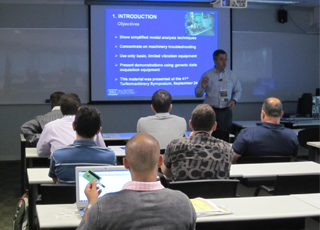Lateral Dynamics
Services > Rotordynamics > Lateral Dynamics
Small radial clearances between rotating and stationary components, as well as the health of surrounding equipment, demand that a machine achieve excellent lateral vibration performance.
The influences of a shaft's surrounding components are often critical in defining a machine's overall lateral dynamics. BRG includes dynamics from the following:
Casing, substructure, & pedestal effects
Fluid film, active magnetic, and rolling element bearings
Electromechanical devices
Squeeze film dampers
Annular seals
BRG conducts several different types of analysis to determine a machine’s lateral vibration performance:
Undamped Critical Speed Analysis
Forced Response Analysis
Stability Analysis
Train & Multilevel Analysis
Lateral Dynamics Analyses
Undamped Critical Speed Analysis
Provides a preliminary estimate of the critical speeds and their sensitivity to support dynamics. In addition, the influence of unbalance distribution as well as component damping can be assessed using the resulting mode shapes.
Undamped mode shapes of steam turbine generator
Undamped critical speed map for an offshore gas injection compressor
Forced Response Analysis
Unbalance response analysis provides the best estimate of critical speed locations and vibration amplitudes. It is crucial for the assessment of separation margins, vibration limits and rubbing risks. Response due to nonsynchronous forcing phenomena can also be determined.
Measured vs. predicted unbalance response of a machine going through its first critical speed
Stability Analysis
A vital analysis for avoiding self-excited instabilities, such as oil whirl and shaft whip. Damped eigenvalues are calculated to determine individual modes' log decrement which indicates their stability level. Influences of operation and components' condition are examined to assess the machine's stability robustness. Synchronous instability due to the Morton effect phenomenon within oil lubricated bearings and seals can also be diagnosed and mitigated using a different type of stability analysis.
Base stability measurements versus predictions for a machine supported by tilting pad journal bearings
API stability sensitivity analysis of an offshore gas injection compressor
Stability spectrum of a subsea compressor supported by active magnetic bearings
Train & Multilevel Analysis
Dynamic interactions between different rotors or rotors with their stators can be significant in some machinery. Long coupling spacers, rigidly coupled trains and flexible casing structures demand these multilevel analyses.
Damped mode shape of a propylene refrigeration compressor train with long coupling spacer
Transient & Nonlinear Analysis
Events such as blade-loss, rubs, rotor drops, and deceleration through critical speeds require analysis in the time domain. Such events and their resulting motions can also be nonlinear. Transient analysis provides a useful design and diagnostic tool for these complex vibrations.
Orbits from a seal rub simulation showing the generation of half frequency whirl

